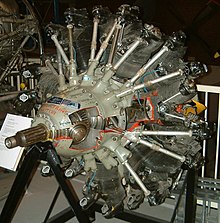Piaggio P. 32
| Piaggio P. 32 | |
|---|---|

|
|
| Type: | bomber |
| Design country: | |
| Manufacturer: | |
| First flight: |
1936 |
| Number of pieces: |
32 |
The Piaggio P.32 was a medium-weight bomber made by the Italian manufacturer Piaggio .
History and construction
After experience gained in the development of test and record aircraft such as the P.16 , P23M and P23R , Piaggio designed the P.32 with relatively small wings, which meant a higher wing loading . This required slats and double wing trailing edge flaps to increase lift during take-off and landing. The P.32 was a twin-engine monoplane with a crew of five or six. The aircraft was made of wood and had a glazed bow, low cockpit, double tail unit and retractable tail wheel landing gearequipped. The body was shaped like a banana. The machine had machine guns for self-defense on and under the hull and in the bow and could load up to 1,600 kg bombs.
The development of the aircraft began in 1934 due to a tender by the Regia Aeronautica . The P.32 was one of many designs, but by far the most modern. The prototype first flew in 1936 and was tested in Guidonia by the Regia Aeronautica, resulting in an order for twelve aircraft. A second order for five copies followed, with these machines being equipped with 615 kW V12 piston engines Isotta Fraschini Asso XI.RC and bearing the designation P.32 I.
In the spring of 1937 the first P.32s were sent to the XXXVII Gruppo BT, 18 Stormo. The wing construction, which was very advanced for the time, required that the machines could only be flown by specially trained crews. As a result, the aircraft turned out to be extremely underpowered and therefore only reached a maximum of 386 km / h - without bombs and without weapons. It was also unable to fly with just one engine and its maneuverability was worse than that of the Savoia-Marchetti SM.79 or the Fiat BR.20 .
The P.32 II was with more powerful Piaggio P.XI-RC-40 - radial engines equipped with 750 kW; in the spring of 1938 twelve pieces were delivered. Due to the more powerful engines, only the climbing performance could be improved. Due to the higher weight, however, the top speed was not increased and the range was reduced from 1950 km to 1700 km with higher fuel consumption.
The entire construction of the P.32bis was revised and equipped with Isotta-Fraschini-Asso-XI engines, which reduced the curb weight from 6355 kg to 5700 kg and reached a top speed of 378 km / h at a service ceiling of 6300 m has been. After installing Piaggio P.XI RC 40 radial engines, the machine even reached 420 km / h and an altitude of 8,000 m. The prototype crashed on February 25, 1938, whereby the test pilot died; the development was not continued afterwards.
The P.32 I and II were withdrawn from active service in April 1938 and only used for training.
variants
- P.32 I - powered by Isotta Fraschini Asso XI.RC V12 piston engines with 615 kW (836 hp) each
- P.32 II - driven by Piaggio P.XI RC 40 radial engines with 750 kW (1,020 hp) each
- Caproni Ca.405 Procellaria - special version of Caproni for the Istres – Damascus – Paris air race in 1937, which was not finished in time
- P.32 bis - revised version of Caproni-Reggiane as about 400 tested with two different engines, a prototype built
Military use
Technical specifications
| Parameter | Data (P.32 I) |
|---|---|
| crew | 5/6 |
| length | 16.3 m |
| span | 18 m |
| height | 5.1 m |
| Wing area | 60 m² |
| Empty mass | 6355 kg |
| Max. Takeoff mass | 9355 kg |
| Cruising speed | ? km / h |
| Top speed | 386 km / h |
| Service ceiling | 7250 m |
| Range | 1950 km |
| Engines | 2 × V12 piston engines Isotta Fraschini Asso XI.RC40 with 615 kW (836 PS) each |
| Armament | 5 × 7.7 mm machine guns Breda-SAFAT 1600 kg bombs |
See also
literature
- Achille Vigna: Il Piaggio P. 32. Storia Militare magazine n.100, November 1997.
- Emilio Brotzu, Michele Caso, Gherardo Cosolo: Bombardieri Ricognitori 4: Ro.37, Ro.43, CZ.501, SM.81, SM.79, Ca.135, Br.20, P.32, Ca.405. Dimensione Cielo, Edizioni dell'Ateneo & Bizzarri, Rome 1972.
- Alberto Sgarlato: Gli altri Reggiane - Alcuni prototipi e progetti non realizzati. Aerei nella storia. (nº 90), 2013, ISSN 1591-1071 .
- Sergio Govi: Il caccia RE2000 e la storia delle "Reggiane". Giorgio Apostolo Editore, Milano 1983, 3rd edition 1987.
Web links
- http://www.aviastar.org/air/italy/piaggio_p-32.php (en), accessed June 22, 2013
- http://www.airwar.ru/enc/bww2/p32.html (ru), accessed June 22, 2013
Individual evidence
- ^ Emilio Brotzu, Michele Caso, Gherardo Cosolo: Bombardieri Ricognitori 4: Ro.37, Ro.43, CZ.501, SM.81, SM.79, Ca.135, Br.20, P.32, Ca.405. Dimensione Cielo, Edizioni dell'Ateneo & Bizzarri, Rome 1972

